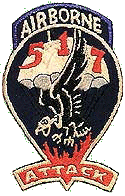INFANTRY REGIMENTAL COMBAT TEAM (SEPARATE)
IN THE VICINITY OF BERGSTEIN, GERMANY
4-8 FEBRUARY 1945. (RHINELAND CAMPAIGN)

By Capt. Roland L. Gohmert
ORGANIZATION AND HISTORY
On 15 March 1943, the 517th Parachute Infantry Regiment was activated as part of the 17th Airborne Division. After a brief training period, followed by airborne maneuvers, the regiment was relieved from the division and a separate combat team was formed. This combat team consisted of the 517th Parachute Infantry Regiment, 460th Parachute Field Artillery Battalion, and the 596th Airborne Engineer Company, all jumpers. (9) This unit was outfitted with only equipment which could be dropped by parachute, and had less vehicles than a standard infantry unit of corresponding composition.
31 May 1943 found the new combat team disembarking at Naples, Italy, and a few days later the four months old unit received its baptism of fire with the 36th Infantry Division near Grossetto, Italy. On 26 June, the combat team was relieved in this sector and moved back to the vicinity of Rome where it staged for the forthcoming invasion of Southern France.
Before daylight on 15 August, troopers of the 517th Combat Team bailed out of their C-47 aircraft in a widely dispersed area inland from The Seventh Army invasion beaches in Southern France. After accomplishing its preliminary missions, the combat team attacked east, until by late September it held a fifteen mile front running generally north from the Mediterranean coast to the Maritime Alps along the French - Italian border. (10) By 16 November, all of the important objectives in that area had been secured and the combat team was relieved by the 14th Armored Division. It was in this rugged mountain fighting that the seriousness of the lack of fire and logistical support, which is so vital to successful sustained ground combat, was first realized. (11)
The 517th then went north by "C-40 & 8" to Soissons, France, where it was attached to XVIII Airborne Corps, along with other major airborne units in Europe. It was expected that First and Ninth Armies would make an early crossing of the Roer and secure the west bank of the Rhine. XVIII Airborne Corps was to be held in readiness at staging areas to secure a bridgehead across the Rhine, by airborne assault, at the first opportunity. (12)
The Germans, however, were well aware of our troop buildup in the Aachen area which weakened our lines to the south, and on 16 December 1944 they launched their counteroffensive in the Ardennes sector. (13) 19 December found the combat team well on its way to helping stem the tide of the onrushing Germans. By the end of January, the 517th had stopped portions of the German attack in three places, had made five major attacks in reducing the German penetrations, and had been attached either in whole or in part to eight different divisions. As one mission was accomplished, orders would be received to move several miles on foot, through knee-deep snow, to launch another attack immediately on arrival in the new sector. Although the combat team accomplished all missions and received many commendations, the "Battle of the Bulge" with its miserable, zero weather had taken a grim toll of the fighting potential of the 517th. Battle casualties had depleted the infantry and engineer strength until the strongest combat company had a bare fifty men. All but a handful of the old leaders were among the casualties which further reduced the combat unity of the team. Personnel remaining in the combat team were little more than walking dead; dysentery, frost bite, trench foot and fatigue were prevalent along with secondary wounds in almost every man. Morale at this point was hanging on tradition and hopes of early relief. (14) These were the proud, fighting paratroopers about which the following action is written.

